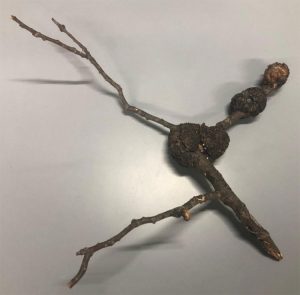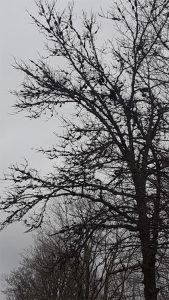Phomopsis Gall
Pest Management Fact Sheet #5061
Developed by Alicyn Smart, Assistant Extension Professor & Extension Plant Pathologist, University of Maine Cooperative Extension, and Nathan Andrews
For information about UMaine Extension programs and resources, visit extension.umaine.edu.
Find more of our publications and books at extension.umaine.edu/publications/.
Pathogen: Phomopsis sp.
Introduction
In Maine, the species of most vulnerability are oaks (Quercus sp.), maples (Acer sp.), and highbush blueberry (Vaccinium corymbosum). The species of most vulnerability is a reflection of the fungus’ adaptation to infect plants with thinner barks. This disease can be commonly mistaken and confused with other galls, including the wasp-induced Gouty Gall and the bacterial disease Crown gall.
Host Plants
Oaks (Quercus sp.), Maples (Acer sp.), Highbush blueberry (Vaccinium corymbosum), Forsythia (Forsythia sp.), Hickories (Carya sp.), and American elm (Ulmus Americana).
Symptoms and Signs
This disease cycle has not been studied in depth. However, galls appear to start forming on twigs and small branches before infection of larger branches or the main stem. Galls begin to form as patches or roughened bark with disorganized hard wood underneath compared to the wood grain of the rest of the plant (Figure 1). When galls are fully formed, they may range from pea size up to the size of a basketball in extreme cases (Figure 2). On most plants, Phomopsis galls appear as clusters of wooden nodules pressed tightly together. On Acer species, the galls will begin as smooth swellings where the bark will eventually roughen and crack as they grow. Phomopsis gall may cause girdling and dieback on infected branches and stems, however, it is not typically fatal for the host. Hosts can live for years and years with galls on the main stem or branches.
- Figure 1. Phomopsis galls on an oak branch, showing disorganized wood grain. Photo by Nathan Andrews.
- Figure 2. Mature Phomopsis galls of multiple sizes on the branches of an oak. Photo by John Archambautlt.
Management
- Galls that get large enough to cause wilting or dieback should be removed.
- Any tools used for removing galls should be sterilized with 70% rubbing alcohol to prevent the spread of the disease
- Burn or dispose of any pruned galls to prevent further transport.
- Space out plants out while planting to increase airflow.
- No fungicides have proved effective with treating Phomopsis gall.
You should check your local town ordinance for any pesticide restrictions before application.
References
Williams, Linda (2017, May 27). Phomopsis Galls on Northern Red Oak. Retrieved from Wisconsin Department of Natural Resources: https://forestrynews.blogs.govdelivery.com/2017/05/26/phomopsis-galls-on-northern-red-oak/
Williams, Linda (2018, May 4). Phomopsis Galls. Retrieved from Wisconsin Department of Natural Resources: https://forestrynews.blogs.govdelivery.com/2018/05/04/phomopsis-galls/
Smith, Sherrie, and Rick Cartwright (2010, April 5). Department of Plant Pathology – Plant Clinic Health News. Issue No. 7. Retrieved from University of Arkansas – Cooperative Extension Service: https://www.uaex.edu/yard-garden/plant-health-clinic/docs/2010_Plant_Health_Clinic_Newsletters/plant%20health%20clinic%20newsletter%20-Issue%207.pdf
Sinclair, Wayne A., and Howard Lyon. Diseases of Trees and Shrubs. Pgs. 148 – 149. Cornell University Press. Copyright 2005. Print.
WHEN USING PESTICIDES, ALWAYS FOLLOW LABEL DIRECTIONS!
Alicyn Smart, DPM
Plant Pathologist and Director of the Plant Disease Diagnostic Laboratory
University of Maine Cooperative Extension
Information in this publication is provided purely for educational purposes. No responsibility is assumed for any problems associated with the use of products or services mentioned. No endorsement of products or companies is intended, nor is criticism of unnamed products or companies implied.
© 2019
Call 800.287.0274 (in Maine), or 207.581.3188, for information on publications and program offerings from University of Maine Cooperative Extension, or visit extension.umaine.edu.
The University of Maine is an EEO/AA employer, and does not discriminate on the grounds of race, color, religion, sex, sexual orientation, transgender status, gender expression, national origin, citizenship status, age, disability, genetic information or veteran’s status in employment, education, and all other programs and activities. The following person has been designated to handle inquiries regarding non-discrimination policies: Sarah E. Harebo, Director of Equal Opportunity, 101 North Stevens Hall, University of Maine, Orono, ME 04469-5754, 207.581.1226, TTY 711 (Maine Relay System).



